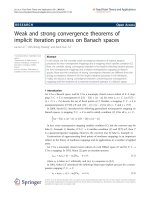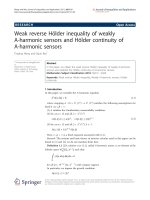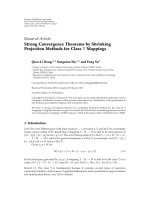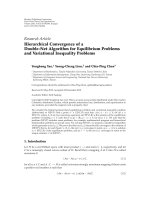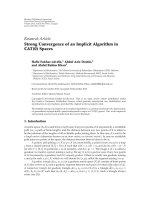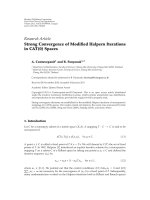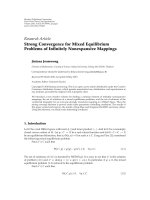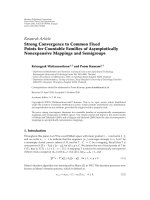Báo cáo hóa học: "WEAK AND STRONG CONVERGENCE OF FINITE FAMILY WITH ERRORS OF NONEXPANSIVE NONSELF-MAPPINGS" docx
Bạn đang xem bản rút gọn của tài liệu. Xem và tải ngay bản đầy đủ của tài liệu tại đây (547.88 KB, 12 trang )
WEAK AND STRONG CONVERGENCE OF FINITE FAMILY
WITH ERRORS OF NONEXPANSIVE NONSELF-MAPPINGS
S. PLUBTIENG AND K. UNGCHITTRAKOOL
Received 27 September 2005; Revised 5 May 2006; Accepted 8 May 2006
We are concerned with the study of a multistep iterative scheme with errors involving
a finite family of nonexpansive nonself-mappings. We approximate the common fixed
points of a finite family of nonexpansive nonself-mappings by weak and strong conver-
gence of the scheme in a unifor mly convex Banach space. Our results extend and improve
some recent results, Shahzad (2005) and many others.
Copyright © 2006 S. Plubtieng and K. Ungchittrakool. This is an open access article dis-
tributed under the Creative Commons Attribution License, which permits unrestricted
use, distribution, and reproduction in any medium, provided the original work is prop-
erly cited.
1. Introduction
Let K be a subset of a real normed linear space E and let T be a self-mapping on K. T is
said to be nonexpansive provided
Tx− Ty x − y for all x, y ∈ K.
Fixed-point iteration process for nonexpansive mappings in Banach spaces includ-
ing Mann and Ishikawa iteration processes has been studied extensively by many au-
thors to solve the nonlinear operator equations in Hilbert spaces and Banach spaces;
see [3, 7, 10, 11, 15, 16]. Tan and Xu [15] introduced and studied a modified Ishikawa
process to approximate fixed points of nonexpansive mappings defined on nonempty
closed convex bounded subsets of a uniformly convex Banach space E.Fiveyearslater,
Xu [18] introduced iterative schemes known as Mann iterative scheme with er rors and
Ishikawa iterative scheme with errors. Takahashi and Tamura [14] introduced and stud-
ied a generalization of Ishikawa iterative schemes for a pair of nonexpansive mappings
in Banach spaces. Recently, Khan and Fukhar-ud-din [6] extended their scheme to the
modified Ishikawa iterative schemes with errors for two mappings and gave weak and
strong convergence theorems. On the other hand, iterative techniques for approximat-
ing fixed p oints of nonexpansive nonself-mappings have been studied by various au-
thors; see [4, 8, 13, 19]. Shahzad [12] introduced and studied an iteration scheme for
Hindawi Publishing Corporation
Fixed Point Theory and Applications
Volume 2006, Article ID 81493, Pages 1–12
DOI 10.1155/FPTA/2006/81493
2 Weak and strong convergence
approximating a fixed point of nonexpansive nonself-mappings (when such a fixed point
exists) and gave some strong and weak convergence theorems for such mappings.
Inspired and motivated by these facts, we introduce and study a multistep iter ative
scheme with errors for a finite family of nonexpansive nonself-mappings. Our schemes
can be viewed as an extension for two-step iterative schemes of Shahzad [12]. The scheme
is defined as follows.
Let K be a nonempty closed convex subset of a uniformly convex Banach space E,
which is also a nonexpansive retract of E.AndletT
1
,T
2
, , T
N
: K → E be nonexpansive
mappings, the following iteration scheme is studied:
x
1
n
= P
α
1
n
T
1
x
n
+ β
1
n
x
n
+ γ
1
n
u
1
n
,
x
2
n
= P
α
2
n
T
2
x
1
n
+ β
2
n
x
n
+ γ
2
n
u
2
n
,
.
.
.
.
.
.
x
n+1
= x
N
n
= P
α
N
n
T
N
x
N
n
− 1+β
N
n
x
n
+ γ
N
n
u
N
n
(1.1)
with x
1
∈ K, n 1, where P is a nonexpansive retraction with respect to K and {α
1
n
},
{α
2
n
}, , {α
N
n
}, {β
1
n
},{β
2
n
}, , {β
N
n
}, {γ
1
n
},{γ
2
n
}, , {γ
N
n
} are sequences in [0,1] with α
i
n
+
β
i
n
+ γ
i
n
= 1foralli = 1,2, ,N,and{u
1
n
},{u
2
n
}, , {u
N
n
} are bounded sequences in K.
For N
= 2, T
1
= T
2
≡ T, β
n
= α
1
n
, α
n
= α
2
n
,andγ
1
n
= γ
2
n
≡ 0, then (1.1) reduces to the
scheme for a mapping defined by Shahzad [12]:
x
1
= x ∈ K,
x
n+1
= P
1 − α
n
x
n
+ α
n
TP
1 − β
n
x
n
+ β
n
Tx
n
,
(1.2)
where
{α
n
}, {β
n
} are sequences in [0,1].
For N
= 2, T
1
,T
2
: K → K, T
1
= T, T
2
= S,andy
n
= x
1
n
,then(1.1) reduces to the
scheme with errors for two mappings defined by
x
1
= x ∈ K,
y
n
= α
1
n
Tx
n
+ β
1
n
x
n
+ γ
1
n
u
1
n
,
x
n+1
= x
2
n
= α
2
n
Sy
n
+ β
2
n
x
n
+ γ
2
n
u
2
n
,
(1.3)
where
{α
1
n
}, {α
2
n
}, {β
1
n
}, {β
2
n
}, {γ
1
n
}, {γ
2
n
} are s equences in [0,1] with α
1
n
+ β
1
n
+ γ
1
n
=1 = α
2
n
+
β
2
n
+ γ
2
n
and {u
1
n
}, {u
2
n
} are bounded sequences in K.
It is our purpose in this paper to establish several weak and strong convergence
theorems of the multistep iterative scheme with errors for a finite family of nonexpansive
nonself-mappings. More precisely, we prove weak convergence of these implicit iteration
S. Plubtieng and K. Ungchittrakool 3
processes in a uniformly convex Banach space which has the Kadec-Klee property. The
results presented in this paper extend and improve the corresponding ones announced
by Shahzad [12], and many others.
2. Preliminaries
In this section, we recall the well-known concepts and results.
Let E be a real Banach space. A subset K of E is said to be a retract of E if there exists
acontinuousmapP : E
→ K such that Px = x for all x ∈ K.AmapP : E → E is said to be
a retraction if P
2
= P. It follows that if a map P is a retraction, then Py= y for all y in
the range of P.AmappingT : K
→ E is called demiclosed with respect to y ∈ E if for each
sequence
{x
n
} in K and each x ∈ E, x
n
x and Tx
n
→ y imply that x ∈ K and Tx = y.A
Banach space E is said to satisfy Opial’s condition [9] if for any sequence
{x
n
} in E, x
n
x
implies that
limsup
n→∞
x
n
− x
< limsup
n→∞
x
n
− y
(2.1)
for all y
∈ E with x = y.ABanachspaceE is said to have the Kadec-Klee property if for
ever y sequence
{x
n
} in E, x
n
x and x
n
→x together imply x
n
− x→0. A family
{T
i
: i = 1,2, ,N} of N nonself-mappings of K (i.e., T
i
: K → E)withF =
N
i
=1
F(T
i
) = ∅
is said to satisfy condition (B)onK if there is a nondecreasing function f :[0,∞) → [0,∞)
with f (0)
= 0and f (r) > 0forallr ∈ (0,∞) such that for all x ∈ K,
max
1iN
x − T
i
x
f
d(x, F)
. (2.2)
The family
{T
i
: i = 1,2, ,N} is said to satisfy condition (A
N
)if(2.2)isreplacedby
1/N
N
i
=1
x − T
i
x f (d(x,F)) for all x ∈ K. Note that condition (B) reduces to condi-
tion (A
N
)whenx − T
1
x=x − T
2
x = ··· = x − T
N
x.
AmappingT : K
→ E is called semicompact if any sequence {x
n
} in K satisfying x
n
−
Tx
n
→0asn →∞has a convergent subsequence.
Lemma 2.1 (Tan and Xu [15]). Let
{s
n
}, {t
n
} be two nonnegative sequences satisfying
s
n+1
s
n
+ t
n
, ∀n 1. (2.3)
If
∞
n=1
t
n
< ∞, then lim
n→∞
s
n
exists. Moreover, if there ex ists a subsequence {s
n
j
} of {s
n
}
such that s
n
j
→ 0 as j →∞, then s
n
→ 0 as n →∞.
Lemma 2.2 (Xu [17]). Let p>1 and R>0 be two fixed numbers and E a Banach space.
Then E is uniformly convex if and only if there exists a continuous, st rictly increasing, and
convex function g :[0,
∞) → [0,∞) with g(0) = 0 such that λx +(1− λ)y
p
λx
p
+
(1
− λ)y
p
− W
p
(λ)g(x − y) for all x, y ∈ B
R
(0) ={x ∈ E : x R},andλ ∈ [0,1],
where W
p
(λ) = λ(1 − λ)
p
+ λ
p
(1 − λ).
Lemma 2.3 (Kaczor [5]). Let E be a real reflexive Banach space such that its dual E
∗
has the
Kadec-Klee property. Let
{x
n
} be a bounded sequence in E and x
∗
, y
∗
∈ ω
w
(x
n
);hereω
w
(x
n
)
4 Weak and strong convergence
denote the set of all weak subsequential limits of
{x
n
}.Supposelim
n→∞
tx
n
+(1−t)x
∗
− y
∗
exists for all t ∈ [0,1]. Then x
∗
= y
∗
.
Lemma 2.4 (Browder [1]). Let E be a uniformly convex Banach space, K anonemptyclosed
convex subset of E,andT : K
→ E a nonexpansive mapping. Then I − T is demiclosed at
zero.
3. Main results
In this section, we prove weak and strong convergence theorems of the iterative scheme
given in (1.1) for a finite family of nonexpansive mappings in a Banach space. In order to
prove our main results, the following lemmas are needed.
Lemma 3.1. Let E be a uniformly convex Banach space and K a nonempty closed con-
vex subset of E which is also a nonexpansive retract of E.LetT
1
,T
2
, , T
N
: K → E be
nonexpansive mappings. Let
{x
n
} bethesequencedefinedby(1.1)with
∞
n=1
γ
i
n
< ∞ for
each i
= 1,2, ,N.If
N
i
=1
F(T
i
) = ∅, then lim
n→∞
x
n
− x
∗
exists for all x
∗
∈
N
i
=1
F(T
i
).
Proof. For each n
1, we note that
x
1
n
− x
∗
α
1
n
T
1
x
n
− x
∗
+ β
1
n
x
n
− x
∗
+ γ
1
n
u
1
n
− x
∗
α
1
n
x
n
− x
∗
+ β
1
n
x
n
− x
∗
+ γ
1
n
u
1
n
− x
∗
x
n
− x
∗
+ d
0
n
,
(3.1)
where d
0
n
= γ
1
n
u
1
n
− x
∗
.Since
∞
n=1
γ
1
n
< ∞,
∞
n=1
d
0
n
< ∞. Next, we note that
x
2
n
− x
∗
α
2
n
T
2
x
1
n
− x
∗
+ β
2
n
x
n
− x
∗
+ γ
2
n
u
2
n
− x
∗
α
2
n
x
1
n
− x
∗
+ β
2
n
x
n
− x
∗
+ γ
2
n
u
2
n
− x
∗
=
α
2
n
+ β
2
n
x
n
− x
∗
+ α
2
n
d
0
n
+ γ
2
n
u
2
n
− x
∗
x
n
− x
∗
+ d
1
n
,
(3.2)
where d
1
n
= α
2
n
d
0
n
+ γ
2
n
u
2
n
− x
∗
.Since
∞
n=1
d
0
n
< ∞ and
∞
n=1
γ
2
n
< ∞,
∞
n=1
d
1
n
< ∞. Simi-
larly, we have
x
3
n
− x
∗
α
3
n
x
2
n
− x
∗
+ β
3
n
x
n
− x
∗
+ γ
3
n
u
3
n
− x
∗
α
3
n
x
n
− x
∗
+ d
1
n
+ β
3
n
x
n
− x
∗
+ γ
3
n
u
3
n
− x
∗
x
n
− x
∗
+ α
3
n
d
1
n
+ γ
3
n
u
3
n
− x
∗
=
x
n
− x
∗
+ d
2
n
,
(3.3)
where d
2
n
= α
3
n
d
1
n
+ γ
3
n
u
3
n
− x
∗
,so
∞
n=1
d
2
n
< ∞.
S. Plubtieng and K. Ungchittrakool 5
By continuing the above method, there exists a nonnegative real sequence
{d
i−1
n
} such
that
∞
n=1
d
i−1
n
< ∞ and
x
i
n
− x
∗
x
n
− x
∗
+ d
i−1
n
, ∀n 1, ∀i = 1,2, , N. (3.4)
Thus
x
n+1
− x
∗
=x
N
n
− x
∗
x
n
− x
∗
+ d
N−1
n
for all n ∈ N.Hence,byLemma 2.1,
lim
n→∞
x
n
− x
∗
exists. This completes the proof.
Lemma 3.2. Let E be a uniformly convex Banach space and K anonemptyclosedconvex
subset of E whichisalsoanonexpansiveretractofE.LetT
1
,T
2
, , T
N
: K → E be nonex-
pansive mappings. Let
{x
n
} bethesequencedefinedby(1.1)with
∞
n=1
γ
i
n
< ∞ and {α
i
n
}⊆
[ε,1 − ε] for all i = 1,2, ,N,forsomeε ∈ (0,1).If
N
i
=1
F(T
i
) = ∅, then lim
n→∞
x
n
−
T
i
x
n
=0 for all i = 1, 2, ,N.
Proof. Let x
∗
∈
N
i
=1
F(T
i
). Then, by Lemma 3.1,lim
n→∞
x
n
− x
∗
exists. Let lim
n→∞
x
n
− x
∗
=r.Ifr = 0, then by the continuity of each T
i
the conclusion follows. Sup-
pose that r>0. Firstly, we are n ow to show that lim
n→∞
T
N
x
n
− x
n
=0. Since {x
n
} and
{u
i
n
} are bounded for all i = 1,2, ,N, there exists R>0suchthatx
n
− x
∗
+ γ
i
n
(u
i
n
− x
n
),
T
i
x
i−1
n
− x
∗
+ γ
i
n
(u
i
n
− x
n
) ∈ B
R
(0) for all n 1andforalli = 1,2, ,N. Using Lemma 2.2,
we have
x
N
n
− x
∗
2
α
N
n
T
N
x
N−1
n
+ β
N
n
x
n
+ γ
N
n
u
N
n
− x
∗
2
=
α
N
n
T
N
x
N−1
n
− x
∗
+ γ
N
n
u
N
n
− x
n
+
1 − α
N
n
x
n
− x
∗
+ γ
N
n
u
N
n
− x
n
2
α
N
n
T
N
x
N−1
n
− x
∗
+ γ
N
n
u
N
n
− x
n
2
+
1 − α
N
n
x
n
− x
∗
+ γ
N
n
u
N
n
− x
n
2
− W
2
α
N
n
g
T
N
x
N−1
n
− x
n
α
N
n
x
N−1
n
− x
∗
+ γ
N
n
u
N
n
− x
n
2
+
1 − α
N
n
x
n
− x
∗
+ γ
N
n
u
N
n
− x
n
2
− W
2
α
N
n
g
T
N
x
N−1
n
− x
n
α
N
n
x
n
− x
∗
+ d
N−2
n
+ γ
N
n
u
N
n
− x
n
2
+
1 − α
N
n
x
n
− x
∗
+ d
N−2
n
+ γ
N
n
u
N
n
− x
n
2
− W
2
α
N
n
g
T
N
x
N−1
n
− x
n
=
x
n
− x
∗
+ λ
N−2
n
2
− W
2
α
N
n
g
T
N
x
N−1
n
− x
n
,
(3.5)
where λ
N−2
n
:= d
N−2
n
+ γ
N
n
u
N
n
− x
∗
.Observethatε
3
W
2
(α
N
n
)now(3.5) implies that
ε
3
g(T
N
x
N−1
n
− x
n
) x
n
− x
∗
2
−x
n+1
− x
∗
2
+ ρ
N−2
n
,whereρ
N−2
n
:= 2λ
N−2
n
x
n
−
x
∗
2
+(λ
N−2
n
)
2
.Since
∞
n=1
d
N−2
n
< ∞ and
∞
n=1
γ
N−2
n
< ∞,weget
∞
n=1
ρ
N−2
n
< ∞. This
implies that lim
n→∞
g(T
N
x
N−1
n
− x
n
) = 0. Since g is strictly increasing and continuous
6 Weak and strong convergence
at 0, it follows that lim
n→∞
T
N
x
N−1
n
− x
n
=0. Note that
x
n
− x
∗
x
n
− T
N
x
N−1
n
+
T
N
x
N−1
n
− x
∗
x
n
− T
N
x
N−1
n
+
x
N−1
n
− x
∗
,
(3.6)
for all n
1. Thus r = lim
n→∞
x
n
− x
∗
liminf
n→∞
x
N−1
n
− x
∗
limsup
n→∞
x
N−1
n
−
x
∗
r and therefore lim
n→∞
x
N−1
n
− x
∗
=r. Using the same argument in the proof
above, we have
x
N−1
n
− x
∗
2
α
N−1
n
x
N−2
n
− x
∗
+ γ
N−1
n
u
N−1
n
− x
∗
2
+
1 − α
N−1
n
x
n
− x
∗
+ γ
N−1
n
u
N−1
n
− x
∗
2
− W
2
α
N−1
n
g
T
N−1
x
N−2
n
− x
n
α
N−1
n
x
n
− x
∗
+ d
N−3
n
+ γ
N−1
n
u
N−1
n
− x
∗
2
+
1 − α
N−1
n
x
n
− x
∗
+ d
N−3
n
+ γ
N−1
n
u
N−1
n
− x
∗
2
− W
2
α
N−1
n
g
T
N−1
x
N−2
n
− x
n
x
n
− x
∗
2
+ ρ
N−3
n
− W
2
α
N−1
n
g
T
N−1
x
N−2
n
− x
n
.
(3.7)
This implies that ε
3
g(T
N−1
x
N−2
n
− x
n
) x
n
− x
∗
2
−x
N−1
n
− x
∗
2
+ ρ
N−3
n
and there-
fore lim
n→∞
T
N−1
x
N−2
n
− x
n
=0. Thus, we have
x
n
− T
N
x
n
x
n
− T
N
x
N−1
n
+
T
N
x
N−1
n
− T
N
x
n
x
n
− T
N
x
N−1
n
+
x
N−1
n
− x
n
=
x
n
− T
N
x
N−1
n
+
P
α
N−1
n
T
N−1
x
N−2
n
+ β
N−1
n
x
n
+ γ
N−1
n
u
N−1
n
−
Px
n
x
n
− T
N
x
N−1
n
+ α
N−1
n
x
n
− T
N−1
x
N−2
n
+ γ
N−1
n
u
N−1
n
− x
n
.
(3.8)
Since lim
n→∞
x
n
− T
N
x
N−1
n
=0, lim
n→∞
x
n
− T
N−1
x
N−2
n
=0, and
∞
n=1
γ
N−1
n
< ∞,it
follows that lim
n→∞
x
n
− T
N
x
n
=0. Similarly, by using the same argument as in the
proof above, we have lim
n→∞
x
n
− T
N−2
x
N−3
n
=lim
n→∞
x
n
− T
N−3
x
N−4
n
=, ,=
lim
n→∞
x
n
−T
2
x
1
n
=0. This implies that lim
n→∞
x
n
−T
N−1
x
n
=lim
n→∞
x
n
− T
N−2
x
n
=
, , = lim
n→∞
x
n
− T
3
x
n
=0. It remains to show that
lim
n→∞
x
n
− T
1
x
n
=
0, lim
n→∞
x
n
− T
2
x
n
=
0. (3.9)
S. Plubtieng and K. Ungchittrakool 7
Note that
x
1
n
− x
∗
2
α
1
n
x
n
− x
∗
+ γ
1
n
u
1
n
− x
∗
2
+
1 − α
1
n
x
n
− x
∗
+ γ
1
n
u
1
n
− x
∗
2
− W
2
α
1
n
g
T
1
x
n
− x
n
=
x
n
− x
∗
+ γ
1
n
u
1
n
− x
∗
2
− W
2
α
1
n
g
T
1
x
n
− x
n
.
(3.10)
Thus, we have ε
3
g(T
1
x
n
− x
n
) (x
n
− x
∗
+ γ
1
n
u
1
n
− x
∗
)
2
−x
1
n
− x
∗
2
and there-
fore lim
n→∞
T
1
x
n
− x
n
=0. Since x
n
− T
2
x
n
x
n
− T
2
x
1
n
+ α
1
n
T
1
x
n
− x
n
+ γ
1
n
u
1
n
−
x
n
, it implies that lim
n→∞
T
2
x
n
− x
n
=0. Therefore lim
n→∞
T
i
x
n
− x
n
=0forall
i
= 1,2, ,N.
Theorem 3.3. Let E be a uniformly convex Banach space and let K be a nonempty closed
convex subset of E which is also a nonexpansive retract of E.LetT
1
,T
2
, , T
N
: K → E be
nonexpansive mappings which are satisfying condition (B).Let
{x
n
} bethesequencedefined
by (1.1)with
∞
n=1
γ
i
n
< ∞ and {α
i
n
}⊆[ε,1 − ε] for all i = 1,2, ,N for some ε ∈ (0,1).If
F :
=
N
i
=1
F(T
i
) = ∅, then {x
n
} converges strongly to a common fixed point in F.
Proof. By Lemma 3.2,lim
n→∞
T
i
x
n
− x
n
=0foralli = 1,2, , N. Now by condition (B),
f (d(x
n
,F)) M
n
:= max
1iN
{T
i
x
n
− x
n
} for all n ∈ N.Hencelim
n→∞
f (d(x
n
,F)) =
0. Since f is a nondecreasing function and f (0) = 0, therefore lim
n→∞
d(x
n
,F) = 0.
Now we can choose a subsequence
{x
n
j
} of {x
n
} and a sequence {y
j
}∈F such that
x
n
j
− y
j
< 2
− j
. By the following method of the proof of Tan and Xu [15], we get that
{y
j
} is a Cauchy sequence in F and so it converges. Let y
j
→ y.SinceF is closed, therefore
y
∈ F and then x
n
j
→ y.ByLemma 3.1,lim
n→∞
x
n
− x
∗
exists for all x
∗
∈ F, x
n
→ y ∈
F.
For N = 2, T
1
= T
2
≡ T, β
n
= α
1
n
, α
n
= α
2
n
,andγ
1
n
= γ
2
n
≡ 0inTheorem 3.3,weobtain
the following results.
Corollary 3.4 (see [12, Theorem 3.6]). Let E be a real uniformly convex Banach space
and K a nonempty closed convex subset of E whichisalsoanonexpansiveretractofE.Let
T : K
→ E be a nonexpansive mapping with F(T) = ∅.Let{α
n
} and {β
n
} be sequences
in [ε,1
− ε] for some ε ∈ (0,1).Fromarbitraryx
1
∈ K, de fine the sequence {x
n
} by the
recursion (1.2). Suppose T satisfies condition (A
1
). Then {x
n
} converges strongly to some
fixed point of T.
When N
= 2, S = T
1
, T = T
2
: C → C,andy
n
= x
1
n
in Theorem 3.3,weobtainstrong
convergence theorem as follows.
Corollary 3.5. Let E be a uniformly convex Banach space and let C be a none mpty
closed convex subset of E whichisalsoanonexpansiveretractofE.LetS, T be nonexpan-
sive mappings of C into itself satisfying condition (A
2
),andlet{x
n
} be sequence defined
by (1.3)with
∞
n=1
γ
1
n
< ∞,
∞
n=1
γ
2
n
< ∞ and 0 <δ α
1
n
, α
2
n
1 − δ<1 for all n ∈ N.If
F :
= F(S) ∩ F(T) = ∅, then {x
n
} converges strongly to a common fixed point of S and T.
8 Weak and strong convergence
Theorem 3.6. Let E be a uniformly convex Banach space and let K be a nonempty closed
convex subset of E which is also a nonexpansive retract of E.LetT
1
,T
2
, , T
N
: K → E be
nonexpansive mappings. Suppose that one of the mappings in
{T
i
: i = 1,2, ,N} is semi-
compact. Let
{x
n
} bethesequencedefinedby(1.1)with
∞
n=1
γ
i
n
< ∞ and {α
i
n
}⊆[ε,1− ε]
for all i
= 1,2, ,N for some ε ∈ (0,1).IfF :=
N
i
=1
F(T
i
) = ∅, then {x
n
} converges strongly
to a common fixed point in F.
Proof. Suppose that T
i
0
is semicompact for some i
0
= 1,2, ,N.ByLemma 3.1,wehave
lim
n→∞
x
n
− T
i
0
x
n
=0. So there exists a subsequence {x
n
j
} of {x
n
} such that x
n
j
→
x
∗
∈ K as j →∞.NowLemma 3.2 guarantees that lim
j→∞
x
n
j
− T
l
x
n
j
=0foralll =
1,2, , N and so x
∗
− T
l
x
∗
=0foralll = 1,2, , N. This implies that x
∗
∈ F.By
Lemma 3.1,lim
n→∞
x
n
− x
∗
exists and then lim
n→∞
x
n
− x
∗
=lim
j→∞
x
n
j
− x
∗
=0.
This completes the proof.
Theorem 3.7. Let E be a uniformly convex Banach space satisfying the Opial’s condition
and K a nonempty closed convex subset of E whichisalsoanonexpansiveretractofE.Let
T
1
,T
2
, , T
N
: K → E be nonexpansive mappings and let {x
n
} be a sequence defined by (1.1)
with
∞
n=1
γ
i
n
< ∞ and {α
i
n
}⊆[ε,1 − ε] for all i = 1,2, ,N for some ε ∈ (0,1).IfF :=
N
i
=1
F(T
i
) = ∅, then {x
n
} converges weakly to a common fixed point in F.
Proof. Let x
∗
∈ F.ThenasprovedinLemma 3.1,lim
x→∞
x
n
− x
∗
exists. Now we prove
that
{x
n
} has a unique weak subsequential limit in F. To prove this, let x
n
i
z
1
and
x
n
j
z
2
for some subsequences {x
n
i
}, {x
n
j
} of {x
n
}.ByLemma 3.2,
lim
i→∞
x
n
i
− T
k
x
n
i
=
0 = lim
j→∞
x
n
j
− T
k
x
n
j
(3.11)
for all k
= 1,2, ,N and by Lemma 2.4 insures that I − T
k
aredemiclosedatzerofor
all k
= 1,2, ,N. T herefore we o btain T
k
z
1
= z
1
and T
k
z
2
= z
2
for all k = 1,2, ,N.
Then z
1
,z
2
∈ F. Next, we prove the uniqueness. Suppose that z
1
= z
2
, then by the Opial’s
condition lim
n→∞
x
n
− z
1
=lim
i→∞
x
n
i
− z
1
< lim
i→∞
x
n
i
− z
2
=lim
j→∞
x
n
j
− z
2
<
lim
j→∞
x
n
j
− z
1
=lim
n→∞
x
n
− z
1
. This is a contradiction. Hence {x
n
} converges
weakly to a point in F.
Lemma 3.8. Let E be a real uniformly c onvex Banach space and K a nonempty closed convex
subset of E whichisalsoanonexpansiveretractofE.LetT
1
,T
2
, , T
N
: K → E be nonexpan-
sive mappings. From arbitrary x
1
∈ K, define the sequence {x
n
} by the recursion (1.1)with
for each i
= 1,2, ,N,
∞
n=1
γ
i
n
< ∞.IfF :=
N
i
=1
F(T
i
) = ∅,thenforallu,v ∈ F, the limit
lim
n→∞
tx
n
+(1− t)u − v
(3.12)
exists for all t
∈ [0,1].
Proof. By Lemma 3.1,wehavelim
n→∞
x
n
− x
∗
exists for all x
∗
∈ F. This implies that
{x
n
} is bounded. Observe that there exists R>0suchthat{x
n
}⊂C := B
R
(0) ∩ K,and
hence C is a nonempty closed convex bounded subset of E.Leta
n
(t):=tx
n
+(1−t)u−v.
Then lim
n→∞
a
n
(0) =u − v,andfromLemma 3.1,lim
n→∞
a
n
(1) = lim
n→∞
x
n
− v ex-
ists. Without loss of generality, we may assume that lim
n→∞
x
n
− u=r>0and
S. Plubtieng and K. Ungchittrakool 9
t
∈ (0,1). For any n 1andforalli = 1,2, ,N,wedefineA
i
n
: C → C by
A
1
n
:= P
α
1
n
T
1
+ β
1
n
I + γ
1
n
u
1
n
,
A
2
n
:= P
α
2
n
T
2
A
1
n
+ β
2
n
I + γ
2
n
u
2
n
,
.
.
.
.
.
.
.
.
.
A
N
n
:= P
α
N
n
T
N
A
N−1
n
+ β
N
n
I + γ
N
n
u
N
n
.
(3.13)
Thus, for all x, y
∈ K,wehaveA
i
n
x − A
i
n
y α
i
n
A
i−1
n
x − A
i−1
n
y + β
i
n
x − y for all
i
= 2, ,N,andA
1
n
x − A
1
n
y α
1
n
x − y + β
1
n
x − y. This implies that
A
N
n
x − A
N
n
y
x − y. (3.14)
Set S
n,m
:= A
N
n+m
−1
A
N
n+m
−2
···A
N
n
, m 1, and b
n,m
:=S
n,m
(tx
n
+(1− t)u) − (tS
n,m
x
n
+
(1
−t)S
n,m
u). It easy to see that A
N
n
x
n
=x
n+1
, S
n,m
x
n
=x
n+m
,andS
n,m
x−S
n,m
y x− y.
We show first that, for any x
∗
∈ F, S
n,m
x
∗
− x
∗
→0 uniformly for all m 1asn →
∞
. Indeed, for any x
∗
∈ F,wehave
A
i
n
x
∗
− x
∗
α
i
n
A
i−1
n
x
∗
− x
∗
+ γ
i
n
u
i
n
− x
∗
(3.15)
for all i
= 2, ,N,andA
1
n
x
∗
− x
∗
γ
1
n
u
1
n
− x
∗
. Therefore
A
N
n
x
∗
− x
∗
σ
2
n
γ
1
n
u
1
n
− x
∗
+ σ
3
n
γ
2
n
u
2
n
− x
∗
+ ···+ σ
N
n
γ
N−1
n
u
N−1
n
− x
∗
+ γ
N
n
u
N
n
− x
∗
M
N
i=1
γ
i
n
,
(3.16)
for all n
1, where M = max{sup
n1
{u
1
n
− x
∗
}, ,sup
n1
{u
N
n
− x
∗
}} and σ
k
n
=
N
i
=k
α
i
n
.Hence
S
n,m
x
∗
− x
∗
A
N
n+m
−1
A
N
n+m
−2
···A
N
n
x
∗
− A
N
n+m
−1
A
N
n+m
−2
···A
N
n+1
x
∗
+
A
N
n+m
−1
A
N
n+m
−2
···A
N
n+1
x
∗
− A
N
n+m
−1
A
N
n+m
−2
···A
N
n+2
x
∗
.
.
.
.
.
.
+
A
N
n+m
−1
x
∗
− x
∗
A
N
n
x
∗
− x
∗
+
A
N
n+1
x
∗
− x
∗
+ ···+
A
N
n+m
−1
x
∗
− x
∗
M
N
i=1
γ
i
n
+ γ
i
n+1
+ ···+ γ
i
n+m
−1
M
N
i=1
∞
k=n
γ
i
k
:= δ
x
∗
n
.
(3.17)
10 Weak and strong convergence
Since
∞
n=1
γ
i
n
<∞,foralli=1,2, , N,wehaveδ
x
∗
n
→0asn→∞ and hence S
n,m
x
∗
−x
∗
→0
as n
→∞.Observethat
a
n+m
(t) =
tS
n,m
x
n
+(1− t)u − v
tS
n,m
x
n
+(1− t)u − S
n,m
tx
n
+(1− t)u
+
S
n,m
tx
n
+(1− t)u
−
v
=
tS
n,m
x
n
+(1− t)S
n,m
u − S
n,m
tx
n
+(1− t)u
+(1− t)
u − S
n,m
u
+
S
n,m
tx
n
+(1− t)u
−
v
b
n,m
+
S
n,m
tx
n
+(1− t)u
−
v
+(1− t)
u − S
n,m
u
b
n,m
+
S
n,m
tx
n
+(1− t)u
−
S
n,m
v
+
S
n,m
v − v
+(1− t)
u − S
n,m
u
b
n,m
+ a
n
(t)+
S
n,m
v − v
+(1− t)
u − S
n,m
u
b
n,m
+ a
n
(t)+δ
v
n
+(1− t)δ
u
n
.
(3.18)
By using [2, Theorem 2.3], we have
b
n,m
ϕ
−1
x
n
− u
−
S
n,m
x
n
− S
n,m
u
=
ϕ
−1
x
n
− u
−
x
n+m
− u + u − S
n,m
u
ϕ
−1
x
n
− u
−
x
n+m
− u
−
S
n,m
u − u
,
(3.19)
and so the sequence
{b
n,m
} convergesuniformlyto0asn →∞for all m 1. Thus, fixing
n and letting m
→∞in (3.19), we have
limsup
m→∞
a
n+m
(t) ϕ
−1
x
n
− u
−
lim
m→∞
x
m
− u
−
δ
u
n
+ a
n
(t)+δ
v
n
+(1− t)δ
u
n
(3.20)
and again letting n
→∞,
limsup
n→∞
a
n
(t) ϕ
−1
(0) + liminf
n→∞
a
n
(t)+0+0= liminf
n→∞
a
n
(t). (3.21)
This completes the proof.
Theorem 3.9. Let E be a real uniformly convex Banach space such that its dual E
∗
has the
Kaded-Klee property and K anonemptyclosedconvexsubsetofE which is also a nonexpan-
sive ret ract of E.LetT
1
,T
2
, , T
N
: K → E be nonexpansive mappings with F :=
N
i
=1
F(T
i
)=
∅.Fromarbitraryx
1
∈ K, define the sequence {x
n
} by the recursion (1.1) with for each
i
= 1,2, ,N,
∞
n=1
γ
i
n
< ∞ and α
i
n
∈ [ε,1 − ε] for some ε ∈ (0,1). Then {x
n
} converges
weakly to some fixed point of T.
Proof. Lemma 3.1 guarantees that
{x
n
} is bounded. Since E is reflexive, there exists a
subsequence
{x
n
j
} of {x
n
} converging w eakly to some x
∗
∈ K.ByLemma 3.2,wehave
S. Plubtieng and K. Ungchittrakool 11
lim
j→∞
x
n
j
− T
i
x
n
j
=0foralli = 1,2, ,N.NowLemma 2.4 guarantees that I − T
i
is
demiclosed at zero for all i
= 1,2, , N. This implies that T
i
x
∗
= x
∗
for all i = 1,2, ,N,
hence this means that x
∗
∈ F. It remains to show that {x
n
} converges weakly to x
∗
.Sup-
pose
{x
n
i
} is another subsequence of {x
n
} converging weakly to some y
∗
.Theny
∗
∈ K
and so x
∗
, y
∗
∈ ω
w
(x
n
) ∩ F.ByLemma 3.8, the limit
lim
n→∞
tx
n
+(1− t)x
∗
− y
∗
(3.22)
exists for all t
∈ [0,1]. By Lemma 2.3 we have x
∗
= y
∗
.Asaresult,ω
w
(x
n
) ∩ F is a single-
ton, and so
{x
n
} converges weakly to some fixed point of T.
Corollary 3.10 (see [12, Theorem 3.5]). Let E be a real uniformly convex Banach space
such that its dual E
∗
has the Kadec-Klee property and K a nonempty closed convex subset of
E whichisalsoanonexpansiveretractofE.LetT : K
→ E be a nonexpansive mapping with
F(T)
= ∅.Let{α
n
} and {β
n
} be sequences in [ε,1 − ε] for some ε ∈ (0,1).Fromarbitrary
x
1
∈ K, defi ne the sequence {x
n
} by the recursion (1.2). Then {x
n
} converges weakly to some
fixed point of T.
Acknowledgments
The authors would like to thank the Faculty of Science, Naresuan University, and the
Thailand Research Fund for financial support. Moreover, the authors thank the referees
for their valuable suggestions to improve this manuscript. This work is supported by
Thailand Research Fund. K. Ungchittrakool is also supported by the Royal Golden Jubilee
Prog ram under Grant PHD/0086/2547, Thailand.
References
[1] F. E. Br owder, Semicontractive and semiaccretive nonlinear mappings in Banach spaces, Bulletin
of the American Mathematical Society 74 (1968), 660–665.
[2] J. Garc
´
ıaFalset,W.Kaczor,T.Kuczumow,andS.Reich,Weak convergence theorems for asymptot-
ically nonexpansive mappings and semigroups, Nonlinear Analysis 43 (2001), no. 3, 377–401.
[3] S. Ishikawa, Fixed points by a new iteration method, Proceedings of the American Mathematical
Society 44 (1974), no. 1, 147–150.
[4] J.S.JungandS.S.Kim,St rong convergence theorems for nonexpansive nonself-mappings in Banach
spaces, Nonlinear Analysis 33 (1998), no. 3, 321–329.
[5] W. Kaczor, Weak convergence of almost orbits of asymptotically nonexpansive commutative semi-
groups, Journal of Mathematical Analysis and Applications 272 (2002), no. 2, 565–574.
[6] S. H. Khan and H. Fukhar-ud-din, Weak and strong convergence of a scheme with errors for two
nonexpansive mappings, Nonlinear Analysis 61 (2005), no. 8, 1295–1301.
[7] W. R. Mann, Mean value methods in iteration, Proceedings of the American Mathematical Soci-
ety 4 (1953), no. 3, 506–510.
[8] S Y. Matsushita and D. Kuroiwa, Strong convergence of averaging iterations of nonexpansive
nonself-mappings, Journal of Mathematical Analysis and Applications 294 (2004), no. 1, 206–
214.
[9] Z. Opial, Weak convergence of the sequence of successive approximations for nonexpansive map-
pings, Bulletin of the American Mathematical Society 73 (1967), 591–597.
[10] B. E. Rhoades, Fixed point iterations for certain nonlinear mappings, Journal of Mathematical
Analysis and Applications 183 (1994), no. 1, 118–120.
12 Weak and strong convergence
[11] J. Schu, Iterative construction of fixed points of asymptotically nonexpansive mappings,Journalof
Mathematical Analysis and Applications 158 (1991), no. 2, 407–413.
[12] N. Shahzad, Approximat ing fixed points of non-self nonexpansive mappings in Banach spaces,
Nonlinear Analysis 61 (2005), no. 6, 1031–1039.
[13] W. Takahashi and G E. Kim, Strong convergence of approximants to fixed points of nonexpansive
nonself-mappings in Banach spaces, Nonlinear Analysis 32 (1998), no. 3, 447–454.
[14] W. Takahashi and T. Tamura, Convergence theorems for a pair of nonexpansive mappings,Journal
of Convex Analysis 5 (1998), no. 1, 45–56.
[15] K K. Tan and H. K. Xu, Approximating fixed points of nonex pansive mappings by the Ishikawa
iteration process, Journal of Mathematical Analysis and Applications 178 (1993), no. 2, 301–308.
[16]
, Fixed point iteration processes for asymptotically nonexpansive mappings, Proceedings of
the American Mathematical Society 122 (1994), no. 3, 733–739.
[17] H. K. Xu, Inequalities in Banach spaces with applications, Nonlinear Analysis 16 (1991), no. 12,
1127–1138.
[18] Y. Xu, Ishikawa and Mann iterative processes with errors for nonlinear strongly accretive operator
equations, Journal of Mathematical Analysis and Applications 224 (1998), no. 1, 91–101.
[19] H. K. Xu and X. M. Yin, Strong convergence theorems for nonexpansive non-self-mappings,Non-
linear Analysis 24 (1995), no. 2, 223–228.
S. Plubtieng: Department of Mathematics, Faculty of Science, Naresuan University,
Phitsanulok 65000, Thailand
E-mail address:
K. Ungchittrakool: Department of Mathematics, Faculty of Science, Naresuan University,
Phitsanulok 65000, Thailand
E-mail address:
